Fabrication of TiO2/NiO p-n Nanocomposite for Enhancement Dye Photodegradation under Solar Radiation
Abstract
:1. Introduction
2. Experimental Details
2.1. Chemicals and Materials
2.2. Synthesis of TiO2 NTs
2.3. Synthesis of NiO NPs
2.4. Nanocomposite TiO2/NiO Loading
2.5. Characterization
2.6. Photocatalytic Activity Test
2.6.1. Influence of Illumination Times and MB Initial Concentrations
2.6.2. Influence of the TiO2/NiO Catalyst Dose
2.6.3. Stability and Reusability of TiO2/NiO Catalyst
3. Results and Discussion
3.1. Characterizations of the Fabricated Nanocomposite
3.1.1. Structure Analysis
3.1.2. Surface Morphological Analysis
3.1.3. EDX Study
3.1.4. Optical Characterization
3.1.5. FT-IR Analysis
3.2. Dye Removal Study
3.2.1. Influence of Illumination Time
3.2.2. Kinetic Modeling
3.2.3. Influence of the MB Concentrations
3.2.4. Influence of the Catalyst Mass
3.2.5. Reusability of the Catalyst
3.2.6. Photocatalytic Mechanism of TiO2/NiO
4. Conclusions
Supplementary Materials
Author Contributions
Funding
Data Availability Statement
Acknowledgments
Conflicts of Interest
References
- Konstantinou, I.K.; Albanis, T.A. TiO2-assisted photocatalytic degradation of azo dyes in aqueous solution: Kinetic and mechanistic investigations: A review. Appl. Catal. B Environ. 2004, 49, 1–14. [Google Scholar] [CrossRef]
- Mohamed, F.; Abukhadra, M.R.; Shaban, M. Removal of safranin dye from water using polypyrrole nanofiber/Zn-Fe layered double hydroxide nanocomposite (Ppy NF/Zn-Fe LDH) of enhanced adsorption and photocatalytic properties. Sci. Total Environ. 2018, 640, 352–363. [Google Scholar] [CrossRef] [PubMed]
- Tio, I. Photodegradation of Commercial Dye, Methylene Blue Using. IPCBEE 2012, 43, 109–113. [Google Scholar] [CrossRef]
- Shaban, M.; Abukhadra, M.R. Geochemical evaluation and environmental application of Yemeni natural zeolite as sorbent for Cd2+ from solution: Kinetic modeling, equilibrium studies, and statistical optimization. Environ. Earth Sci. 2017, 76, 310. [Google Scholar] [CrossRef]
- Wu, J.; Wang, G.; Li, Z.; Yu, E.; Xie, J.; Zheng, Z. Extraction of flocculants from a strain of Bacillus thuringiensis and analysis of their properties. Aquac. Fish. 2017, 2, 179–184. [Google Scholar] [CrossRef]
- Sivakumar, M.; Towata, A.; Yasui, K.; Tuziuti, T.; Kozuka, T.; Iida, Y. Dependence of sonochemical parameters on the platinization of rutile titania—An observation of a pronounced increase in photocatalytic efficiencies. Ultrason. Sonochem. 2010, 17, 621–627. [Google Scholar] [CrossRef]
- Mohamed, F.; Hassaballa, S.; Shaban, M.; Ahmed, A.M. Highly Efficient Photocatalyst Fabricated from the Chemical Recycling of Iron Waste and Natural Zeolite for Super Dye Degradation. Nanomaterials 2022, 12, 235. [Google Scholar] [CrossRef]
- Liu, Q.; Sun, J.; Han, D.; Liu, X.; Gao, X.; Jiang, Y.; Xie, K. Highly efficient photocatalytic removal of methylene blue by lamellar structured nanocrystalline and amorphous CuO. Mater. Lett. 2020, 276, 128217. [Google Scholar] [CrossRef]
- Chandekar, K.V.; Shkir, M.; Al-Shehri, B.M.; AlFaify, S.; Halor, R.G.; Khan, A.; Al-Namshah, K.S.; Hamdy, M.S. Visible light sensitive Cu doped ZnO: Facile synthesis, characterization and high photocatalytic response. Mater. Charact. 2020, 165, 110387. [Google Scholar] [CrossRef]
- Ali, I.; Park, S.; Kim, J.O. Modeling the photocatalytic reactions of g-C3N4-TiO2 nanocomposites in a recirculating semi-batch reactor. J. Alloys Compd. 2020, 821, 153498. [Google Scholar] [CrossRef]
- Sabouri, Z.; Akbari, A.; Hosseini, H.A.; Khatami, M.; Darroudi, M. Egg white-mediated green synthesis of NiO nanoparticles and study of their cytotoxicity and photocatalytic activity. Polyhedron 2020, 178, 114351. [Google Scholar] [CrossRef]
- Frindy, S.; Sillanpää, M. Synthesis and application of novel α-Fe2O3/graphene for visible-light enhanced photocatalytic degradation of RhB. Mater. Des. 2020, 188, 108461. [Google Scholar] [CrossRef]
- Muneer, M.; Bahnemann, D.; Qamar, M.; Tariq, M.A.; Faisal, M. Photocatalysed reaction of few selected organic systems in presence of titanium dioxide. Appl. Catal. A Gen. 2005, 289, 224–230. [Google Scholar] [CrossRef]
- Tariq, M.A.; Faisal, M.; Muneer, M.; Bahnemann, D. Photochemical reactions of a few selected pesticide derivatives and other priority organic pollutants in aqueous suspensions of titanium dioxide. J. Mol. Catal. A Chem. 2007, 265, 231–236. [Google Scholar] [CrossRef]
- Abu Tariq, M.; Faisal, M.; Muneer, M. Semiconductor-mediated photocatalysed degradation of two selected azo dye derivatives, amaranth and bismarck brown in aqueous suspension. J. Hazard. Mater. 2005, 127, 172–179. [Google Scholar] [CrossRef]
- Atrees, M.S.; Ebraheim, E.E.; Ali, M.E.M.; Yasser, M.; Mahmoud, M.S.; Almutairi, M.M. Environmental Effects Synergetic effect of metal-doped GO and TiO2 on enhancing visible-light-driven photocatalytic hydrogen production from water splitting. Energy Sources Part A Recover. Util. Environ. Eff. 2021, 43, 484–494. [Google Scholar] [CrossRef]
- Rabia, M.; Mohamed, S.H.; Zhao, H.; Shaban, M.; Lei, Y.; Ahmed, A.M. TiO2/TiOxNY hollow mushrooms-like nanocomposite photoanode for hydrogen electrogeneration. J. Porous Mater. 2020, 27, 133–139. [Google Scholar] [CrossRef]
- Sun, Z.; Pichugin, V.F.; Evdokimov, K.E.; Konishchev, M.E.; Syrtanov, M.S.; Kudiiarov, V.N.; Li, K.; Tverdokhlebov, S.I. Effect of nitrogen-doping and post annealing on wettability and band gap energy of TiO2 thin film. Appl. Surf. Sci. 2020, 500. [Google Scholar] [CrossRef]
- Chen, G.; Ji, S.; Sang, Y.; Chang, S.; Wang, Y.; Hao, P.; Claverie, J.; Liu, H.; Yu, G. Synthesis of scaly Sn3O4/TiO2 nanobelt heterostructures for enhanced UV-visible light photocatalytic activity. Nanoscale 2015, 7, 3117–3125. [Google Scholar] [CrossRef]
- Li, X.; Liu, H.; Luo, D.; Li, J.; Huang, Y.; Li, H.; Fang, Y.; Xu, Y.; Zhu, L. Adsorption of CO2 on heterostructure CdS(Bi2S3)/TiO2 nanotube photocatalysts and their photocatalytic activities in the reduction of CO2 to methanol under visible light irradiation. Chem. Eng. J. 2012, 180, 151–158. [Google Scholar] [CrossRef]
- Cao, T.; Li, Y.; Wang, C.; Wei, L.; Shao, C.; Liu, Y. Fabrication, structure, and enhanced photocatalytic properties of hierarchical CeO2 nanostructures/TiO2 nanofibers heterostructures. Mater. Res. Bull. 2010, 45, 1406–1412. [Google Scholar] [CrossRef]
- Liu, Z.; Zhou, C. Improved photocatalytic activity of nano CuO-incorporated TiO2 granules prepared by spray drying. Prog. Nat. Sci. Mater. Int. 2015, 25, 334–341. [Google Scholar] [CrossRef] [Green Version]
- Lv, Y.R.; Liu, C.J.; He, R.K.; Li, X.; Xu, Y.H. BiVO4/TiO2 heterojunction with enhanced photocatalytic activities and photoelectochemistry performances under visible light illumination. Mater. Res. Bull. 2019, 117, 35–40. [Google Scholar] [CrossRef]
- Cao, Y.Q.; Zi, T.Q.; Zhao, X.R.; Liu, C.; Ren, Q.; Fang, J.B.; Li, W.M.; Li, A.D. Enhanced visible light photocatalytic activity of Fe2O3 modified TiO2 prepared by atomic layer deposition. Sci. Rep. 2020, 10, 13437. [Google Scholar] [CrossRef]
- Nasr, M.; Huang, W.; Bittencourt, C.; Cui, D.; Sun, Y.; Wang, L.; Caperaa, N.G.; Ning, Y.; Song, P.; Bonnet, P.; et al. Synthesis of BiOF/TiO2 Heterostructures and Their Enhanced Visible-Light Photocatalytic Activity. Eur. J. Inorg. Chem. 2020, 2020, 253–260. [Google Scholar] [CrossRef]
- ACS Applied Materials & Interfaces. Carbon-Incorporated NiO/TiO2 Mesoporous Shells with p–n Heterojunctions for Efficient Visible Light Photocatalysis. Available online: https://pubs.acs.org/doi/abs/10.1021/acsami.6b10480 (accessed on 14 March 2020).
- Shifu, C.; Sujuan, Z.; Wei, L.; Wei, Z. Preparation and activity evaluation of p-n junction photocatalyst NiO/TiO2. J. Hazard. Mater. 2008, 155, 320–326. [Google Scholar] [CrossRef]
- Fujita, S.-i.; Kawamori, H.; Honda, D.; Yoshida, H.; Arai, M. Photocatalytic hydrogen production from aqueous glycerol solution using NiO/TiO2 catalysts: Effects of preparation and reaction conditions. Appl. Catal. B Environ. 2016, 181, 818–824. [Google Scholar] [CrossRef]
- Buama, S.; Junsukhon, A.; Ngaotrakanwiwat, P.; Rangsunvigit, P. Validation of energy storage of TiO2[sbnd]NiO/TiO2 film by electrochemical process and photocatalytic activity. Chem. Eng. J. 2017, 309, 866–872. [Google Scholar] [CrossRef]
- Liang, Z.; Ouyang, B.; Wang, T.; Liu, X.; Huo, H.; Liu, D.; Feng, H.; Ma, J.; Deng, K.; Li, A.; et al. Pt modified TiO2/NiO p-n junction with enhanced surface reaction and charge separation for efficient photocatalytic hydrogen evolution. Int. J. Hydrog. Energy 2022, 47, 10868–10876. [Google Scholar] [CrossRef]
- Wang, M.; Hu, Y.; Han, J.; Guo, R.; Xiong, H.; Yin, Y. TiO2/NiO hybrid shells: P-n junction photocatalysts with enhanced activity under visible light. J. Mater. Chem. A 2015, 3, 20727–20735. [Google Scholar] [CrossRef]
- Liu, J.; Li, Y.; Ke, J.; Wang, S.; Wang, L.; Xiao, H. Black NiO-TiO2 nanorods for solar photocatalysis: Recognition of electronic structure and reaction mechanism. Appl. Catal. B Environ. 2018, 224, 705–714. [Google Scholar] [CrossRef]
- Chen, C.J.; Liao, C.H.; Hsu, K.C.; Wu, Y.T.; Wu, J.C.S. P-N junction mechanism on improved NiO/TiO2 photocatalyst. Catal. Commun. 2011, 12, 1307–1310. [Google Scholar] [CrossRef]
- Ahmed, A.M.; Mohamed, F.; Ashraf, A.M.; Shaban, M.; Aslam Parwaz Khan, A.; Asiri, A.M. Enhanced photoelectrochemical water splitting activity of carbon nanotubes@TiO2 nanoribbons in different electrolytes. Chemosphere 2020, 238, 124554. [Google Scholar] [CrossRef]
- Liu, J.; Tao, Z.; Xie, H.; Zhang, X.; Wang, H.; Xiao, H.; Wang, L. Facial construction of defected NiO/TiO2 with Z-scheme charge transfer for enhanced photocatalytic performance. Catal. Today 2019, 335, 269–277. [Google Scholar] [CrossRef]
- Sabzehparvar, M.; Kiani, F.; Tabrizi, N.S. Mesoporous-assembled TiO2-NiO-Ag nanocomposites with p-n/Schottky heterojunctions for enhanced photocatalytic performance. J. Alloys Compd. 2021, 876, 160133. [Google Scholar] [CrossRef]
- Zhu, Q.; Liu, N.; Zhang, N.; Song, Y.; Stanislaus, M.S.; Zhao, C.; Yang, Y. Efficient photocatalytic removal of RhB, MO and MB dyes by optimized Ni/NiO/TiO2 composite thin films under solar light irradiation. J. Environ. Chem. Eng. 2018, 6, 2724–2732. [Google Scholar] [CrossRef]
- Baygi, N.J.; Saghir, A.V.; Beidokhti, S.M.; Khaki, J.V. Modified auto-combustion synthesis of mixed-oxides TiO2/NiO nanoparticles: Physical properties and photocatalytic performance. Ceram. Int. 2020, 46, 15417–15437. [Google Scholar] [CrossRef]
- Faisal, M.; Harraz, F.A.; Ismail, A.A.; El-Toni, A.M.; Al-Sayari, S.A.; Al-Hajry, A.; Al-Assiri, M.S. Novel mesoporous NiO/TiO2 nanocomposites with enhanced photocatalytic activity under visible light illumination. Ceram. Int. 2018, 44, 7047–7056. [Google Scholar] [CrossRef]
- Castañeda, C.; Martínez, J.J.; Santos, L.; Rojas, H.; Osman, S.M.; Gómez, R.; Luque, R. Caffeine photocatalytic degradation using composites of NiO/TiO2–F and CuO/TiO2–F under UV irradiation. Chemosphere 2022, 288, 132506. [Google Scholar] [CrossRef]
- Li, Q.; Zhang, J.; Liu, B.; Li, M.; Liu, R.; Li, X.; Ma, H.; Yu, S.; Wang, L.; Zou, Y.; et al. Synthesis of high-density nanocavities inside TiO2-B nanoribbons and their enhanced electrochemical lithium storage properties. Inorg. Chem. 2008, 47, 9870–9873. [Google Scholar] [CrossRef] [PubMed]
- Hao, L.; Hu, Y.; Zhang, Y.; Ping, X.; Liu, T.; Zhao, Q. Flexible TiO2 nanograss array film decorated with BiOI nanoflakes and its greatly boosted photocatalytic activity. Ceram. Int. 2020, 47, 7845–7852. [Google Scholar] [CrossRef]
- Liang, Z.Y.; Huang, R.K.; Liang, R.W.; Chen, F.; Yu, Y.; Yan, G.Y. Preparation of a shell nanostructure for highly selective photocatalytic oxidation of organic compounds by wrapping on NiO nanorods exposed {110} facets with ultrathin g-C3N4 nanosheets. Appl. Surf. Sci. 2019, 484, 424–432. [Google Scholar] [CrossRef]
- Shaban, M.; Zayed, M.; Hamdy, H. Nanostructured ZnO thin films for self-cleaning applications. RSC Adv. 2017, 7, 617–631. [Google Scholar] [CrossRef]
- Zayed, M.; Ahmed, A.M.; Shaban, M. Synthesis and characterization of nanoporous ZnO and Pt/ZnO thin films for dye degradation and water splitting applications. Int. J. Hydrogen Energy 2019, 44, 17630–17648. [Google Scholar] [CrossRef]
- Sivaraman, T.; Balu, A.R.; Nagarethinam, V.S. Materials Science in Semiconductor Processing Effect of magnesium incorporation on the structural, morphological, optical and electrical properties of CdS thin films. Mater. Sci. Semicond. Process. 2014, 27, 915–923. [Google Scholar] [CrossRef]
- Shaban, M.; Ahmed, A.M.; Shehata, N.; Betiha, M.A.; Rabie, A.M. Ni-doped and Ni/Cr co-doped TiO2 nanotubes for enhancement of photocatalytic degradation of methylene blue. J. Colloid Interface Sci. 2019, 555, 31–41. [Google Scholar] [CrossRef]
- Zhao, H.; Li, C.-F.; Liu, L.-Y.; Palma, B.; Hu, Z.-Y.; Renneckar, S.; Larter, S.; Li, Y.; Kibria, M.G.; Hu, J.; et al. n-p Heterojunction of TiO2-NiO core-shell structure for efficient hydrogen generation and lignin photoreforming. J. Colloid Interface Sci 2021, 585, 694–704. [Google Scholar] [CrossRef]
- Zhi, J.; Chen, A.; Cui, H.; Xie, Y.; Huang, F. NiO-decorated mesoporous TiO2 flowers for an improved photovoltaic dye sensitized solar cell. Phys. Chem. Chem. Phys. 2015, 17, 5103–5108. [Google Scholar] [CrossRef]
- Jasim, M.M.; Dakhil, O.A.A.; Hussein, E.H.; Abdullah, H.I. Enhanced photoelectrochemical properties of NiO nanoparticles-decorated TiO2 nanotube arrays for water splitting. J. Mater. Sci. Mater. Electron. 2020, 31, 10707–10714. [Google Scholar] [CrossRef]
- Vinoth, R.; Karthik, P.; Devan, K.; Neppolian, B.; Ashokkumar, M. TiO2–NiO p–n nanocomposite with enhanced sonophotocatalytic activity under diffused sunlight. Ultrason. Sonochem. 2017, 35, 655–663. [Google Scholar] [CrossRef] [PubMed]
- Fuerte, A.; Hernández-Alonso, M.D.; Maira, A.J.; Martínez-Arias, A.; Fernández-García, M.; Conesa, J.C.; Soria, J.; Munuera, G. Nanosize Ti-W mixed oxides: Effect of doping level in the photocatalytic degradation of toluene using sunlight-type excitation. J. Catal. 2002, 212, 1–9. [Google Scholar] [CrossRef]
- Sharma, R.; Acharya, A.D.; Shrivastava, S.B.; Patidar, M.M.; Gangrade, M.; Shripathi, T.; Ganesan, V. Studies on the structure optical and electrical properties of Zn-doped NiO thin films grown by spray pyrolysis. Optik 2016, 127, 4661–4668. [Google Scholar] [CrossRef]
- Ahmed, A.M.; Rabia, M.; Shaban, M. The structure and photoelectrochemical activity of Cr-doped PbS thin films grown by chemical bath deposition. RSC Adv. 2020, 10, 14458–14470. [Google Scholar] [CrossRef]
- Nail, B.A.; Fields, J.M.; Zhao, J.; Wang, J.; Greaney, M.J.; Brutchey, R.L.; Osterloh, F.E. Nickel Oxide Particles Catalyze Photochemical Hydrogen Evolution from Water; Nanoscaling Promotes P-Type Character and Minority Carrier Extraction. ACS Nano 2015, 9, 5135–5142. [Google Scholar] [CrossRef]
- Sreethawong, T.; Ngamsinlapasathian, S.; Yoshikawa, S. Surfactant-aided sol-gel synthesis of mesoporous-assembled TiO2-NiO mixed oxide nanocrystals and their photocatalytic azo dye degradation activity. Chem. Eng. J. 2012, 192, 292–300. [Google Scholar] [CrossRef]
- Mary, J.A.; Vijaya, J.J.; Dai, J.H.; Bououdina, M.; John Kennedy, L.; Song, Y. Experimental and first-principles DFT studies of electronic, optical and magnetic properties of cerium-manganese codoped zinc oxide nanostructures. Mater. Sci. Semicond. Process. 2015, 34, 27–38. [Google Scholar] [CrossRef]
- Shaban, M.; El Sayed, A.M. Influences of lead and magnesium co-doping on the nanostructural, optical properties and wettability of spin coated zinc oxide films. Mater. Sci. Semicond. Process. 2015, 39, 136–147. [Google Scholar] [CrossRef]
- Mannaa, M.A.; Qasim, K.F.; Alshorifi, F.T.; El-Bahy, S.M.; Salama, R.S. Role of NiO Nanoparticles in Enhancing Structure Properties of TiO2 and Its Applications in Photodegradation and Hydrogen Evolution. ACS Omega 2021, 6, 30386–30400. [Google Scholar] [CrossRef]
- Zheng, D.; Zhao, H.; Wang, S.; Hu, J.; Chen, Z. NiO-TiO2 p-n Heterojunction for Solar Hydrogen Generation. Catalysts 2021, 11, 1427. [Google Scholar] [CrossRef]
- Liang, Z.; Li, J.; He, X.; Niu, L.; Xu, X. Fabrication of p-NiO nanoparticles/n-TiO2 nanospheres photocatalysts and their photocatalytic performance for degradation of Rh B. J. Nanoparticle Res. 2019, 21, 221. [Google Scholar] [CrossRef]
- Dom, R.; Baby, L.R.; Kim, H.G.; Borse, P.H. Fe controlled charge-dynamics in ZnO for solar hydrogen generation. Int. J. Hydrog. Energy 2017, 42, 5758–5767. [Google Scholar] [CrossRef]
- Chai, W.; Zhu, W.; Chen, D.; Chen, D.; Xi, H.; Chang, J.; Zhang, J.; Zhang, C.; Hao, Y. Combustion-processed NiO/ALD TiO2 bilayer as a novel low-temperature electron transporting material for efficient all-inorganic CsPbIBr2 solar cell. Sol. Energy 2020, 203, 10–18. [Google Scholar] [CrossRef]
- He, X.; Gui, Y.; Liu, K.; Xu, L. Comparison of sensing and electronic properties of C2H2 on different transition metal oxide nanoparticles (Fe2O3, NiO, TiO2) modified BNNT (10, 0). Appl. Surf. Sci. 2020, 521, 146463. [Google Scholar] [CrossRef]
- Ravi, P.; Navakoteswara Rao, V.; Shankar, M.V.; Sathish, M. CuO@NiO core-shell nanoparticles decorated anatase TiO2 nanospheres for enhanced photocatalytic hydrogen production. Int. J. Hydrogen Energy 2020, 45, 7517–7529. [Google Scholar] [CrossRef]
- Wang, T.-T.; Chiang, C.L.; Lin, Y.C.; Srinivasadesikan, V.; Lin, M.C.; Lin, Y.G. KSCN-activation of hydrogenated NiO/TiO2 for enhanced photocatalytic hydrogen evolution. Appl. Surf. Sci. 2020, 511, 145548. [Google Scholar] [CrossRef]
- Chen, S.; Zhao, W.; Liu, W.; Zhang, S. Preparation, characterization and activity evaluation of p-n junction photocatalyst p-ZnO/n-TiO2. Appl. Surf. Sci. 2008, 255, 2478–2484. [Google Scholar] [CrossRef]
- León, A.; Reuquen, P.; Garín, C.; Segura, R.; Vargas, P.; Zapata, P.; Orihuela, P.A. FTIR and raman characterization of TiO2 nanoparticles coated with polyethylene glycol as carrier for 2-methoxyestradiol. Appl. Sci. 2017, 7, 49. [Google Scholar] [CrossRef]
- Bezrodna, T.; Puchkovska, G.; Shymanovska, V.; Baran, J.; Ratajczak, H. IR-analysis of H-bonded H2O on the pure TiO2 surface. J. Mol. Struct. 2004, 700, 175–181. [Google Scholar] [CrossRef]
- Mugundan, S.; Rajamannan, B.; Viruthagiri, G.; Shanmugam, N.; Gobi, R.; Praveen, P. Synthesis and characterization of undoped and cobalt-doped TiO2 nanoparticles via sol–gel technique. Appl. Nanosci. 2015, 5, 449–456. [Google Scholar] [CrossRef] [Green Version]
- Roy, A.K.; Prasad, K.; Prasad, A. Piezoelectric, impedance, electric modulus and AC conductivity studies on (Bi0.5Na0.5)0.95Ba0.05TiO3 ceramic. Processing Appl. Ceram. 2013, 7, 81–91. [Google Scholar] [CrossRef]
- Mahalingam, T.; Selvakumar, C.; Ranjith Kumar, E.; Venkatachalam, T. Structural, optical, morphological and thermal properties of TiO2–Al and TiO2–Al2O3 composite powders by ball milling. Phys. Lett. Sect. A Gen. At. Solid State Phys. 2017, 381, 1815–1819. [Google Scholar] [CrossRef]
- Wei, Z.; Qiao, H.; Yang, H.; Zhu, L.; Yan, X. Preparation and characterization of NiO nanoparticles by anodic arc plasma method. J. Nanomater. 2009, 2009, 795928. [Google Scholar] [CrossRef] [Green Version]
- Kalam, A.; Al-Shihri, A.S.; Shakir, M.; El-Bindary, A.A.; Sayed, E.; Yousef, S.; Du, G.; Al-Shihri, S. Synthesis and Reactivity in Inorganic, Metal-Organic, and Nano-Metal Chemistry Spherical NiO Nanoparticles (SNPs): Synthesis, Characterization, and Optical Properties Spherical NiO Nanoparticles (SNPs): Synthesis, Characterization, and Optical Properties. Synth. React. Inorganic, Met. Nano-Metal Chem. 2011, 41, 1324–1330. [Google Scholar] [CrossRef]
- Yu, J.; Ran, J. Facile preparation and enhanced photocatalytic H2-production activity of Cu(OH)2 cluster modified TiO2. Energy Environ. Sci. 2011, 4, 1364–1371. [Google Scholar] [CrossRef]
- Xiang, Q.; Yu, J.; Jaroniec, M. Enhanced photocatalytic H2-production activity of graphene-modified titania nanosheets. Nanoscale 2011, 3, 3670–3678. [Google Scholar] [CrossRef] [PubMed]
- Yu, J.; Hai, Y.; Cheng, B. Enhanced photocatalytic H2-production activity of TiO2 by Ni(OH)2 cluster modification. J. Phys. Chem. C 2011, 115, 4953–4958. [Google Scholar] [CrossRef]
- Ran, J.; Yu, J.; Jaroniec, M. Ni(OH)2 modified CdS nanorods for highly efficient visible-light-driven photocatalytic H2 generation. Green Chem. 2011, 13, 2708–2713. [Google Scholar] [CrossRef]
- Wang, W.; Liu, S.; Nie, L.; Cheng, B.; Yu, J. Enhanced photocatalytic H2-production activity of TiO2 using Ni(NO3)2 as an additive. Phys. Chem. Chem. Phys. 2013, 15, 12033–12039. [Google Scholar] [CrossRef] [PubMed]
- Tran, P.D.; Xi, L.; Batabyal, S.K.; Wong, L.H.; Barber, J.; Chye Loo, J.S. Enhancing the photocatalytic efficiency of TiO2 nanopowders for H2 production by using non-noble transition metal co-catalysts. Phys. Chem. Chem. Phys. 2012, 14, 11596–11599. [Google Scholar] [CrossRef]
- Chen, J.; Chen, T.; Lai, L.; Li, P.; Liu, H.; Hong, Y.; Liu, D. Preparation and Characterization of Surface Photocatalytic Activity with NiO/TiO2 Nanocomposite Structure. Materials 2015, 8, 4273–4286. [Google Scholar] [CrossRef] [Green Version]
- Sun, S.P.; Li, C.J.; Sun, J.H.; Shi, S.H.; Fan, M.H.; Zhou, Q. Decolorization of an azo dye Orange G in aqueous solution by Fenton oxidation process: Effect of system parameters and kinetic study. J. Hazard. Mater. 2009, 161, 1052–1057. [Google Scholar] [CrossRef] [PubMed]
- Behnajady, M.A.; Modirshahla, N.; Hamzavi, R. Kinetic study on photocatalytic degradation of C.I. Acid Yellow 23 by ZnO photocatalyst. J. Hazard. Mater. 2006, 133, 226–232. [Google Scholar] [CrossRef] [PubMed]
- Huang, Y.H.; Huang, Y.F.; Chang, P.S.; Chen, C.Y. Comparative study of oxidation of dye-Reactive Black B by different advanced oxidation processes: Fenton, electro-Fenton and photo-Fenton. J. Hazard. Mater. 2008, 154, 655–662. [Google Scholar] [CrossRef] [PubMed]
- Cheng, X.; Shang, Y.; Cui, Y.; Shi, R.; Zhu, Y.; Yang, P. Enhanced photoelectrochemical and photocatalytic properties of anatase-TiO2(B) nanobelts decorated with CdS nanoparticles. Solid State Sci. 2020, 99, 106075. [Google Scholar] [CrossRef]
- Vedichi, M.; Mani, S. Materials Today: Proceedings Enhanced microwave and photocatalytic decomposition of synthetic lignin wastewater by TiO2 nanoparticles coated on activated carbon. Mater. Today Proc. 2020, 47, 800–806. [Google Scholar] [CrossRef]
- Hasan, J.; Li, H.; Tian, G.; Qin, C. Fabrication of Cr2S3-GO-TiO2 composite with high visible-light-driven photocatalytic activity on degradation of organic dyes. Chem. Phys. 2020, 539, 110950. [Google Scholar] [CrossRef]
- Ali, A.; Shoeb, M.; Li, Y.; Li, B.; Asim, M. Enhanced photocatalytic degradation of antibiotic drug and dye pollutants by graphene-ordered mesoporous silica (SBA 15)/TiO2 nanocomposite under visible-light irradiation. Infect. Genet. Evol. 2020, 20, 118–123. [Google Scholar] [CrossRef]
- Badvi, K.; Javanbakht, V. Enhanced photocatalytic degradation of dye contaminants with TiO2 immobilized on ZSM-5 zeolite modi fi ed with nickel nanoparticles. J. Clean. Prod. 2021, 280, 124518. [Google Scholar] [CrossRef]
- Ahmed, M.A.; El-katori, E.E.; Gharni, Z.H. Photocatalytic degradation of methylene blue dye using Fe2O3/TiO2 nanoparticles prepared by sol–gel method. J. Alloys Compd. 2013, 553, 19–29. [Google Scholar] [CrossRef]
- Yu, J.; Wang, W.; Cheng, B. Synthesis and enhanced photocatalytic activity of a hierarchical porous flowerlike p-n junction NiO/TiO2 photocatalyst. Chem. Asian J. 2010, 5, 2499–2506. [Google Scholar] [CrossRef] [PubMed]
- Environ, E.; Zhou, H.; Qu, Y.; Duan, X. Environmental Science Towards highly efficient photocatalysts using semiconductor nanoarchitectures. Energy Environ. Sci. 2012, 5, 6732–6743. [Google Scholar] [CrossRef]
- Liang, Y.C.; Xu, N.C.; Chiang, K.J. Surface morphology-dependent functionality of titanium dioxide–nickel oxide nanocomposite semiconductors. Nanomaterials 2019, 9. [Google Scholar] [CrossRef] [PubMed] [Green Version]
- Yu, X.; Zhang, J.; Zhao, Z.; Guo, W.; Qiu, J.; Mou, X.; Li, A.; Claverie, J.P.; Liu, H. NiO-TiO2 p-n heterostructured nanocables bridged by zero-bandgap rGO for highly efficient photocatalytic water splitting. Nano Energy 2015, 16, 207–217. [Google Scholar] [CrossRef]
- Wen, Z.B.; Yu, F.; You, T.; Zhu, L.; Zhang, L.; Wu, Y.P. A core-shell structured nanocomposite of NiO with carbon nanotubes as positive electrode material of high capacitance for supercapacitors. Mater. Res. Bull. 2016, 74, 241–247. [Google Scholar] [CrossRef]
- Dvoranová, D.; Barbieriková, Z.; Brezová, V. Radical intermediates in photoinduced reactions on TiO2 (An EPR spin trapping study). Molecules 2014, 19, 17279–17304. [Google Scholar] [CrossRef] [PubMed] [Green Version]

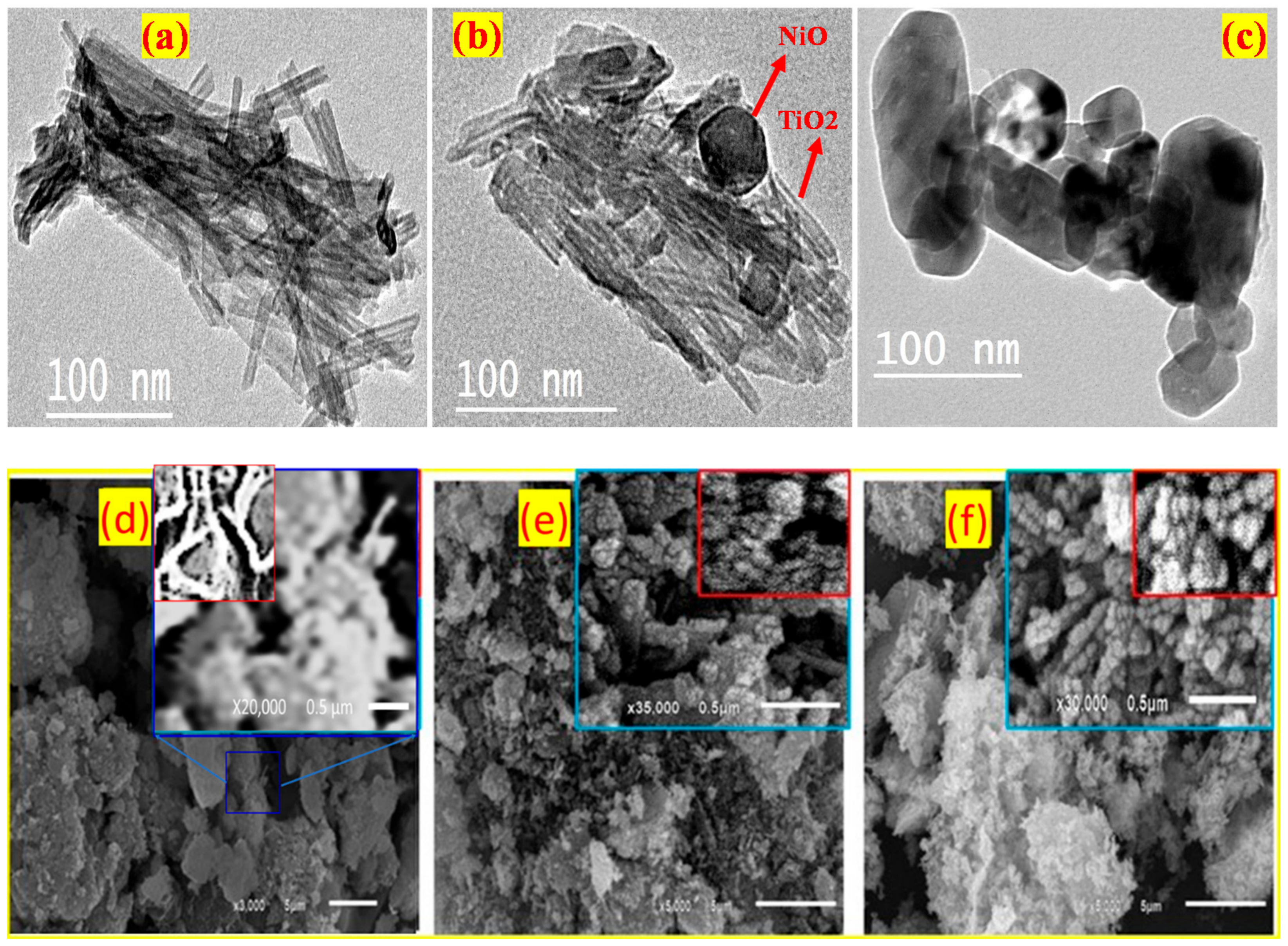
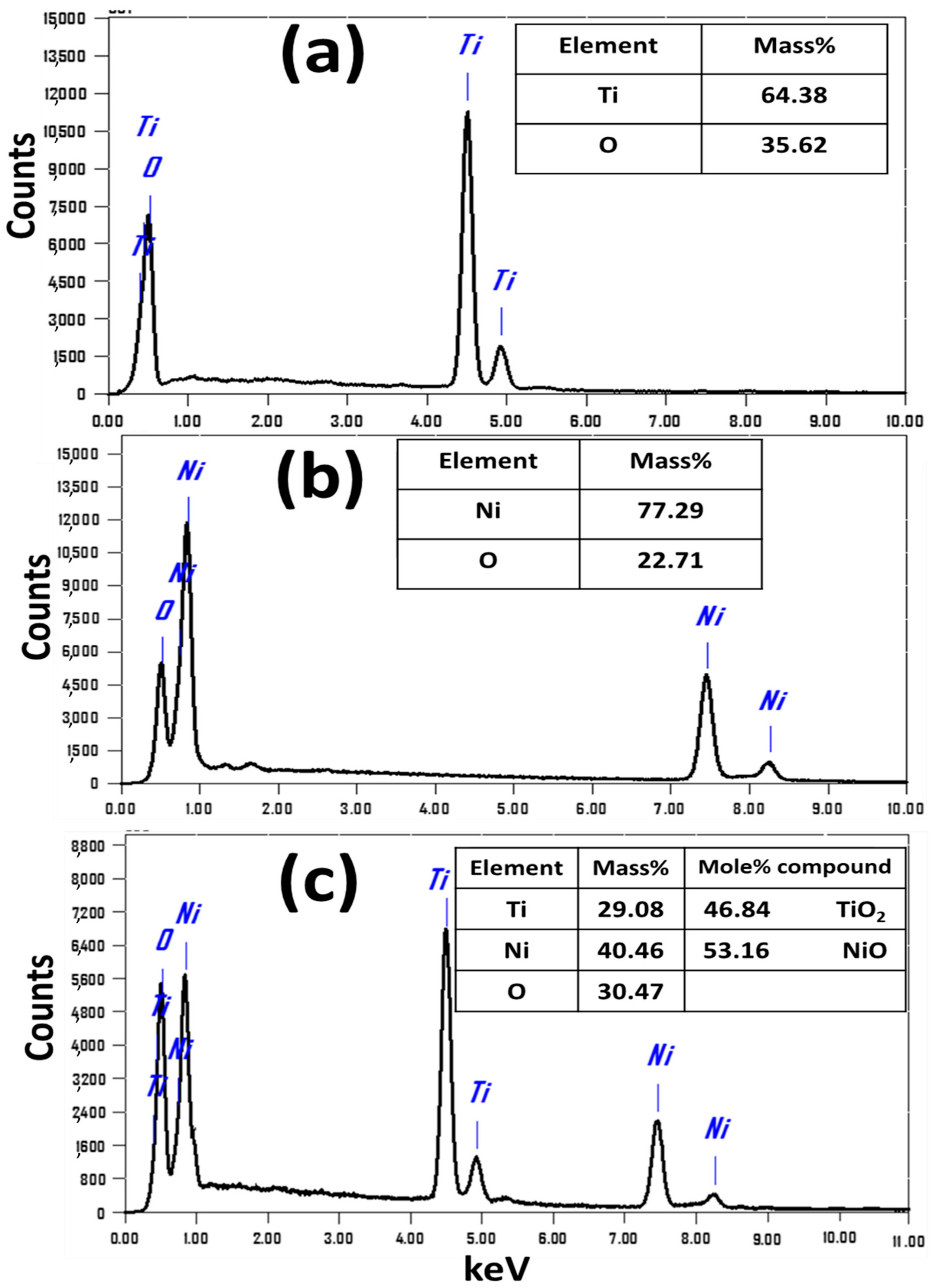
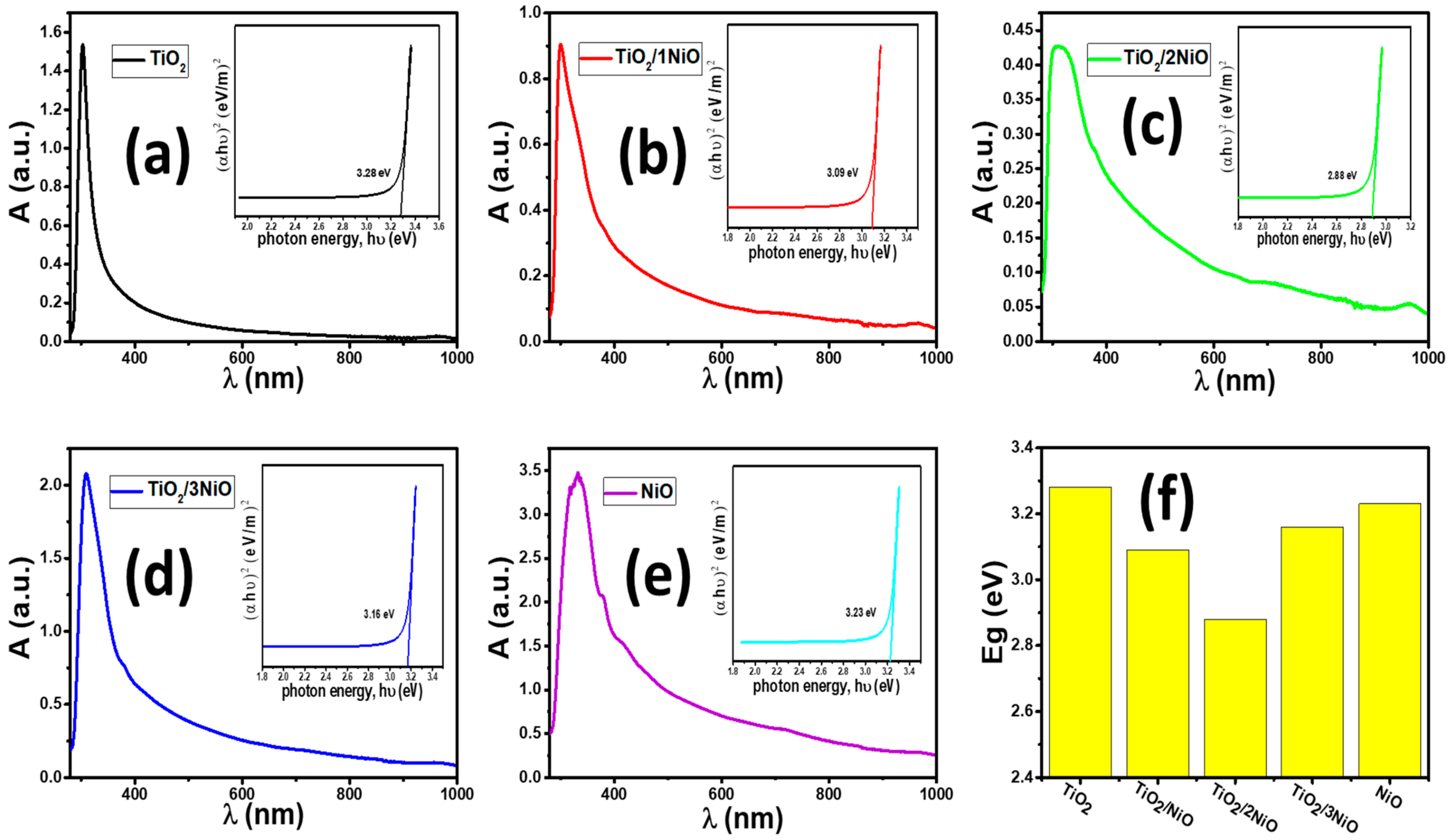
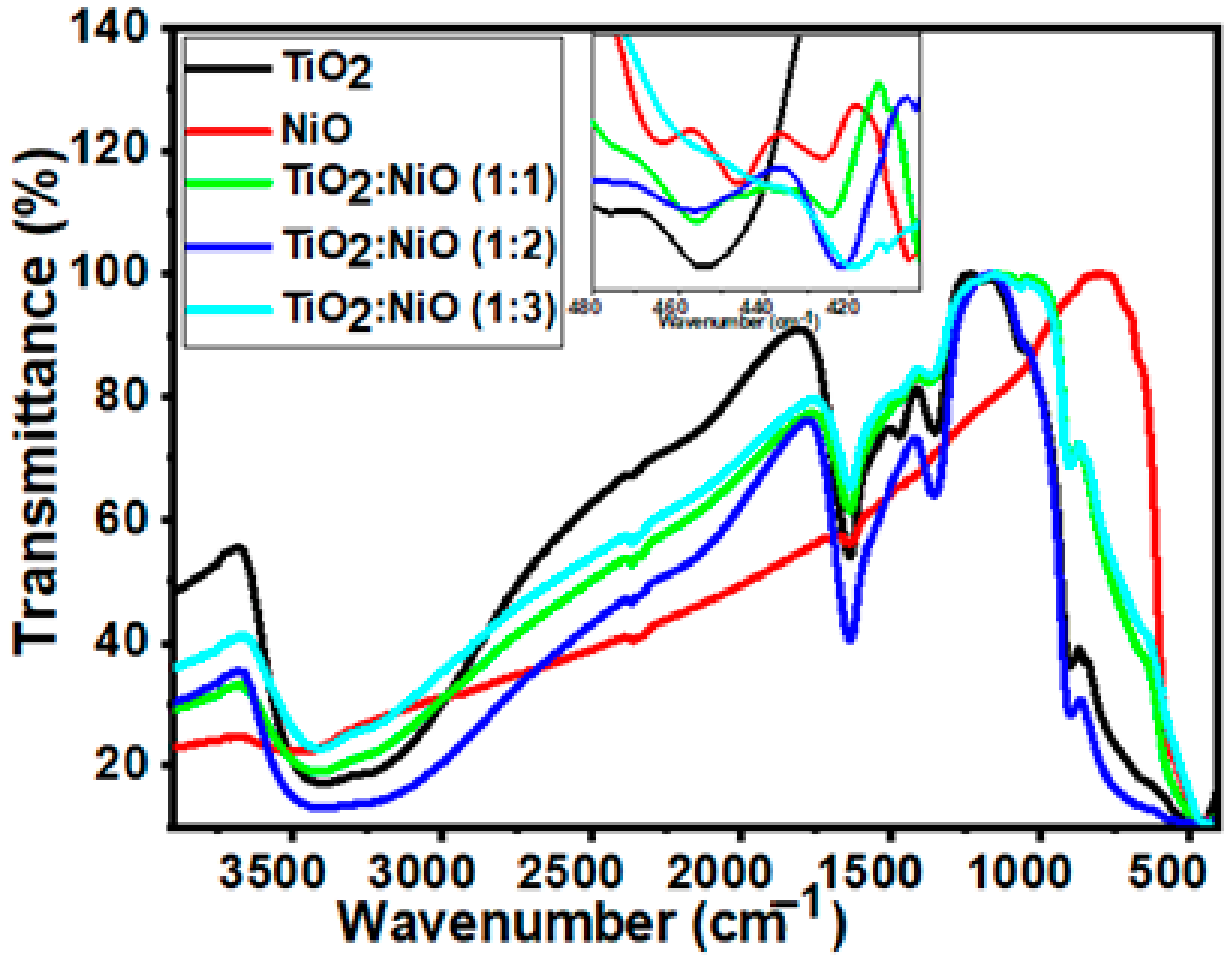



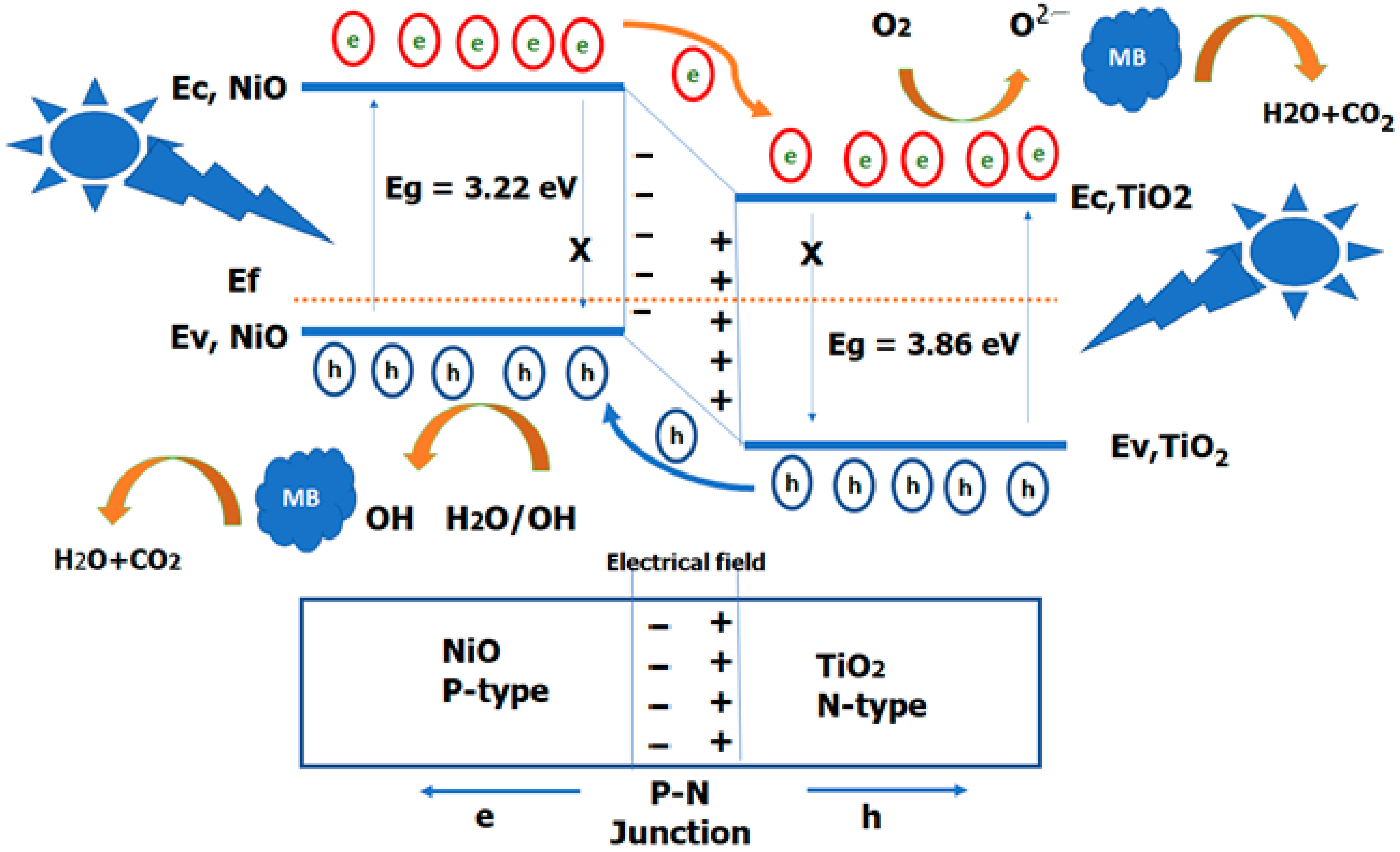
| Sample | hkl | 2θ | d (A°) | D (A°) | TC |
|---|---|---|---|---|---|
| TiO2 NTs | (201) | 24.41 | 3.65 | 72.83 | 0.76 |
| (002) | 28.69 | 3.11 | 58.76 | 1.87 | |
| (−311) | 33.51 | 2.67 | 99.22 | 0.84 | |
| (311) | 39.29 | 2.29 | 50.35 | 0.50 | |
| (020) | 48.25 | 1.89 | 252.6 | 2.22 | |
| (512) | 61.77 | 1.5 | 55.26 | 0.56 | |
| (520) | 69.82 | 1.35 | 57.83 | 0.25 | |
| NiO NPs | (111) | 37.30 | 2.41 | 352.5 | 1.15 |
| (200) | 43.32 | 2.09 | 359.4 | 1.89 | |
| (220) | 62.91 | 1.48 | 301.6 | 0.72 | |
| (311) | 75.41 | 1.26 | 501.7 | 0.24 | |
| TiO2/2NiO (NiO crystallites) | (111) | 37.37 | 2.41 | 352.6 | 1.14 |
| (200) | 43.39 | 2.09 | 312.5 | 1.86 | |
| (220) | 63.01 | 1.48 | 341.2 | 0.75 | |
| (311) | 75.52 | 1.26 | 803 | 0.25 |
| Samples | Zero | First | Second | |||
|---|---|---|---|---|---|---|
| K0 | R2 | K1 | R2 | K2 | R2 | |
| TiO2 NTs | −0.01603 | 0.86242 | 0.02838 | 0.96471 | 0.05529 | 0.99367 |
| TiO2/1NiO | −0.01540 | 0.76118 | 0.03245 | 0.92756 | 0.08020 | 0.93822 |
| TiO2/2NiO | −0.01848 | 0.67713 | 0.09682 | 0.96600 | 1.19736 | 0.90219 |
| TiO2/3NiO | −0.01270 | 0.85215 | 0.01865 | 0.93224 | 0.02868 | 0.97726 |
| NiO NPs | −0.01646 | 0.84477 | 0.03087 | 0.96170 | 0.06487 | 0.99384 |
| Catalyst | Light Source | Irradiation Time (min) | Dye Removal (%) | Ref. |
|---|---|---|---|---|
| 1TiO2/2NiO | Solar Light | 25 | 99.5 | Present work |
| CdS/TiO2 | Solar Light | 30 | 91.9 | [85] |
| activated carbon/ TiO2 | Micro-Wave | 60 | 99 | [86] |
| Cr2S3/GO/TiO2 | visible light | 120 | 98.3 | [87] |
| Graphene/silica/TiO2 | visible light | 60 | 98 | [88] |
| TiO2/zeolite/Ni | UV irradiation | 120 | 99.08 | [89] |
Publisher’s Note: MDPI stays neutral with regard to jurisdictional claims in published maps and institutional affiliations. |
© 2022 by the authors. Licensee MDPI, Basel, Switzerland. This article is an open access article distributed under the terms and conditions of the Creative Commons Attribution (CC BY) license (https://creativecommons.org/licenses/by/4.0/).
Share and Cite
Zayed, M.; Samy, S.; Shaban, M.; Altowyan, A.S.; Hamdy, H.; Ahmed, A.M. Fabrication of TiO2/NiO p-n Nanocomposite for Enhancement Dye Photodegradation under Solar Radiation. Nanomaterials 2022, 12, 989. https://doi.org/10.3390/nano12060989
Zayed M, Samy S, Shaban M, Altowyan AS, Hamdy H, Ahmed AM. Fabrication of TiO2/NiO p-n Nanocomposite for Enhancement Dye Photodegradation under Solar Radiation. Nanomaterials. 2022; 12(6):989. https://doi.org/10.3390/nano12060989
Chicago/Turabian StyleZayed, Mohamed, Salsbeel Samy, Mohamed Shaban, Abeer S. Altowyan, Hany Hamdy, and Ashour M. Ahmed. 2022. "Fabrication of TiO2/NiO p-n Nanocomposite for Enhancement Dye Photodegradation under Solar Radiation" Nanomaterials 12, no. 6: 989. https://doi.org/10.3390/nano12060989








